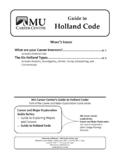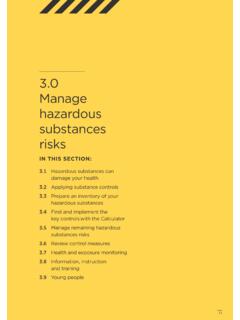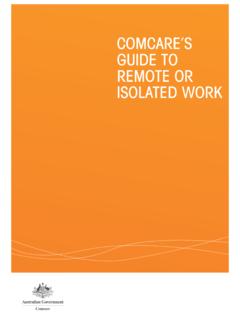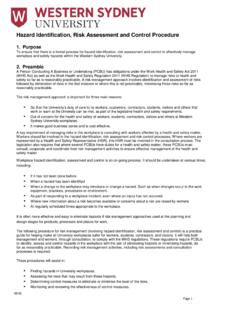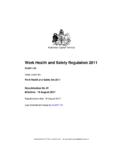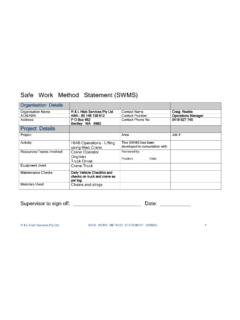Transcription of A quick guide to health and safety in ports
1 health and safety ExecutiveA quick guide to health and safety in portsHealth and safety ExecutiveA quick guide to health and safety in portsThis is a web-friendly version of leaflet INDG446, published 01/111 of # pagesIntroductionPorts are often challenging places to work. You may be dealing with a whole range of cargoes and working alongside a wide variety of people, including some who don t speak at ports takes place throughout the day and night and in all types of weather. There are often pressures to load or unload a ship s cargo quickly to catch a tide or to free up a wharf. Visiting drivers want to pick up or drop off their cargo as quickly as possible and get back on the road. These factors make it an exciting but also a potentially high-risk industry to work in. Ever-changing circumstances lead to ever-changing risks. Companies must put appropriate health and safety measures in place to manage these risks properly. How this guide can help youIt highlights the main hazards found in ports and outlines what you need to do to comply with the law.
2 You can find sources of more advice from the health and safety Executive (HSE) and the port industry itself at the end of the guide . There are also details of how to get advice in different guide is mainly aimed at employers and other dutyholders but it should be helpful to all those carrying out work in ports . This includes stevedores, visiting drivers and also anyone who may work at docks occasionally. Some of the specialised and high-risk activities associated with handling dangerous goods and hazardous cargoes at docks are not covered. You can find advice on those areas on the HSE website ( ). What are the main legal requirements?Under the health and safety at Work etc Act 1974 (HSW Act), employers, people in control of premises, the self-employed and employees must ensure the health and safety of others and themselves. There are also regulations that apply to all industries because many of the hazards will be the same. But some industries do have specific pieces of legislation.
3 In the port industry, these include:the Docks Regulations 1988; 2 of 11 pagesHealth and safety ExecutiveA quick guide to health and safety in portsthe Dangerous Substances in Harbour Areas Regulations 1987; and the Loading and Unloading of Fishing Vessels Regulations 1988. The Approved Code of Practice safety in Docks (COP25) covers the Docks Regulations 1988 but much of that material has been repealed and replaced by more recent legislation. See Want to know more? at the end of this guide for details. The HSW Act and associated regulations do not apply to seamen working onboard ship under the control of the ship s master. Comparable Merchant Shipping health and safety Regulations do apply to ships crew and are enforced by the Maritime and Coastguard Agency (MCA). Successfully managing health and safety in ports Port work often involves a number of different employers and/or contractors who can all affect each other s activities.
4 These may include harbour authorities, port operators, stevedoring firms, hauliers, ships masters and need to have strong and effective health and safety systems in place. These should ensure co-operation, co-ordination and communication between all employers and their Management of health and safety at Work Regulations 1999 set out a number of requirements for employers to ensure they are adequately managing health and safety . These include: a risk assessment of their activities. This should identify the measures they need to have in place to comply with their duties under health and safety law and reduce risks so far as is reasonably practicable; making sure there is effective planning, organisation, control, monitoring and review of the measures they put in place;appointing a competent person to provide health and safety assistance. A competent person is someone with the necessary skills, knowledge and experience to manage health and safety ;providing employees with information they can understand including people whose first language is not English; andco-operation and co-ordination with other employers sharing a workplace.
5 HSE s Managing health and safety in dockwork (HSG177) provides more detailed guidance on the management responsibilities of the many employers and contractors involved in the industry. See Want to know more? at the end of this with workers By law, employers must consult with all their employees on health and safety matters. Consulting employees about health and safety can result in:healthier and safer workplaces as worker input is valuable to identify hazards, assess risks and develop ways to control risks;better decisions about health and safety because they are based on the input of workers who have knowledge of the job;3 of 11 pagesHealth and safety ExecutiveA quick guide to health and safety in portsstronger commitment to implementing decisions or actions because employees have been actively involved in reaching these decisions;greater co-operation and trust. In some instances, subsidies may be available for training safety representatives.
6 Which laws apply? safety Representatives and safety Committees Regulations 1977 for employers where trade unions are recognised by the employer and representatives have been and safety (Consultation with Employees) Regulations 1996 for employers where trade unions are not if things go wrong?This guide is mainly about prevention. But sometimes things do go wrong. If someone has been hurt or becomes ill at work, it s important to take care of them straightaway, and make any dangerous conditions safe. First aidImmediately and properly examining and treating injuries may save life and is essential to reduce pain and help injured people make a quick recovery. The health and safety (First Aid) Regulations 1981 require employers to have adequate arrangements for first reporting Employers, the self-employed and those in control of premises must report certain accidents and incidents at work under the Reporting of Injuries, Diseases and Dangerous Occurrences Regulations 1995 (RIDDOR).
7 This covers accidents to everyone at work and non-workers, such as members of the public, affected by the work. You can find information on reporting incidents at: Tackling the hazardsWorkplace transport Most transport-related accidents in ports are serious or fatal. Many different employers drivers use ports . Not all of these drivers will be familiar with the port environment. Workplace transport safety will only be managed properly if everyone works workplace transport hazards in portsLoading and unloading of vehicles. 4 of 11 pagesHealth and safety ExecutiveA quick guide to health and safety in portsMovement of vehicles and other plant on the dockside. Trailer coupling and uncoupling on the dockside and on the ship. Vehicle/pedestrian access, eg ro-ro bridges and vessel ramps. Reversing vehicles on ro-ro decks. Movement of vehicles in container storage areas and lorry parks. How you can reduce workplace transport risksThese can be grouped under: Safe site, Safe vehicle, Safe driver.
8 You need to deal with all three of these to ensure good control of workplace transport siteEvery workplace should be safe for the people and vehicles using it. Provide appropriate road signs and markings. Vehicles and pedestrians should be separated where they share the same workspace. This may involve excluding pedestrians from certain areas or providing separate pedestrian vehicle Vehicles should be safe, provided with suitable visibility aids, regularly maintained, repaired and driver All drivers should be fit and competent to operate all the vehicles they use at work. Workers should follow safe working practices. Management should monitor these practices. Which laws apply?Workplace ( health , safety and Welfare) Regulations 1992 Provision and Use of Work Equipment Regulations 1998 (PUWER) Lifting operationsLoading and unloading at ports involves the use of a wide range of lifting equipment. This may include gantry cranes, slewing cranes, forklift trucks or other similar machinery.
9 Poorly planned lifting operations can lead to significant risks to people working in the area. Typical hazards from lifting equipmentAccidents have occurred due to:failure of lifting equipment; falling loads; and workers being crushed by a moving load or lifting equipment. How you can reduce risks from lifting equipment Use suitable lifting equipment to securely lift cargo. Use a competent person to plan the lift. This plan should include the order of work, route, weight, slinging/spreader method and what to do in the event of a shifted load or bad t lift over areas where people are likely to be working or passing. All lifting equipment and accessories should be properly inspected and examined. Ensure employees and supervisors are trained, competent and experienced in safe lifting. 5 of 11 pagesHealth and safety ExecutiveA quick guide to health and safety in portsIf a ship s lifting equipment is to be used, ensure that it is suitable and subject to a pre-use examination.
10 Check the ship s documentation of thorough laws apply?Lifting Operations and Lifting Equipment Regulations 1998 (LOLER) Provision and Use of Work Equipment Regulations 1998 (PUWER) Falls from heightMany of the activities carried out in ports could lead to a fall from height. These activities may be during routine operations or during one-off maintenance activities. In ports , the added hazard of working near water means a fall may lead to the risk of falls from height hazards in portsAccess to and from vessels by accommodation ladders and gangways. Container-top working lashing and unlashing containers, use of slewing jib to and from places of work onboard vessels (holds, hatches, decks etc). Falls from vehicles during loading/unloading and sheeting. Falls from car transporters. Maintenance work. Unloading some types of cargo, such as pipework, timber packs etc, can result in open edges from ships decks, passages and from the cargo adjacent to open edges of docks, wharves etc.











